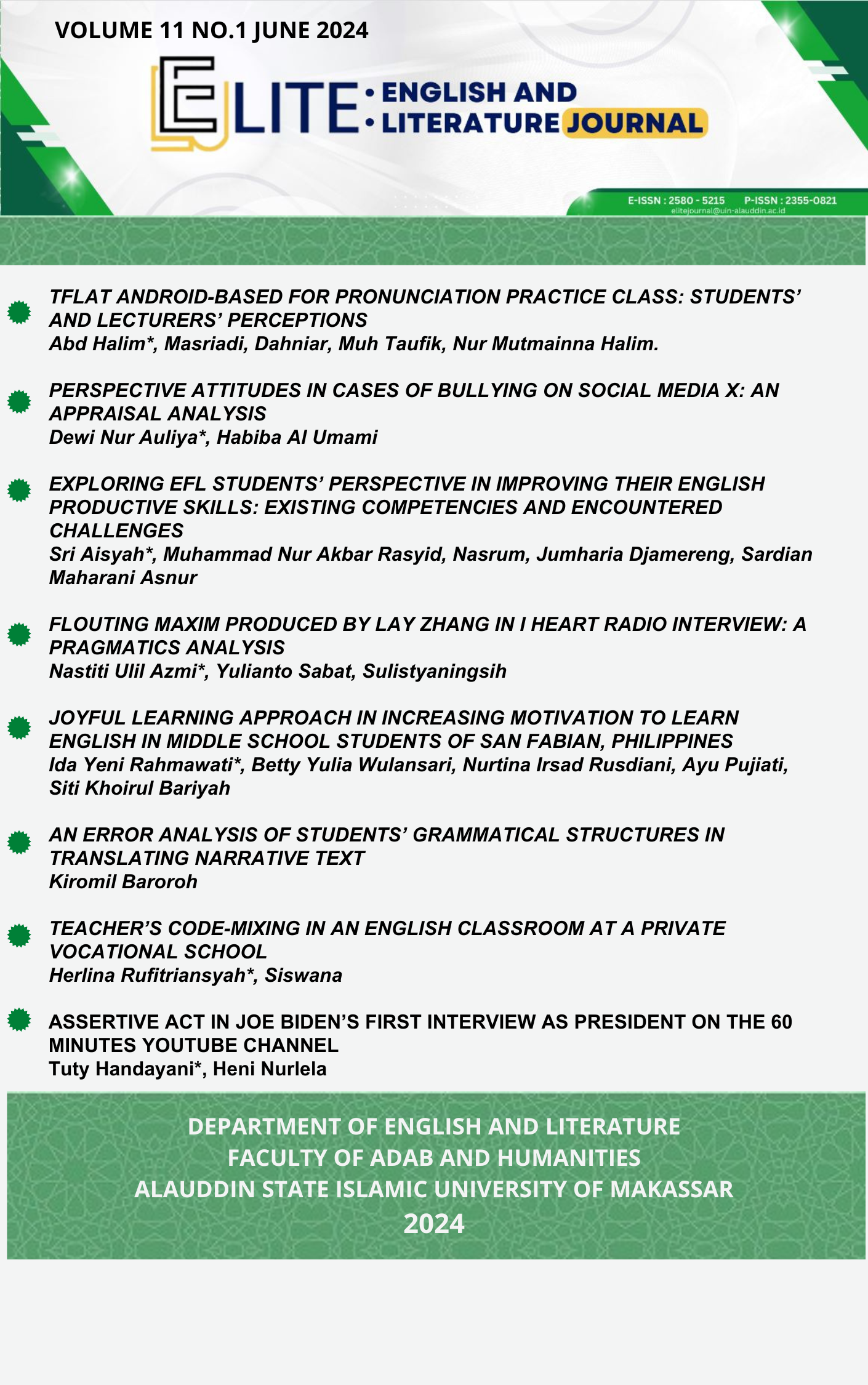TFLAT ANDROID-BASED FOR PRONUNCIATION PRACTICE CLASS: STUDENTS AND LECTURERS' PERCEPTIONS
Abstract
This study aims to examine the perception of using the TFlat English Pronunciation application and determine how students and instructors view the app, its influence on language learning, and its possible advantages. The research used E-Learning theory adapted from Akaslan and Law (2010) and employed qualitative methods to explore diverse user experiences. To find out the perceptions of informants (10 students and 1 lecturer), the researchers interviewed them to investigate more about the usefulness of this application. The findings revealed that students found TFlat to be a valuable application for improving their English pronunciation in E-learning. They appreciated the user-friendly features and accessibility of TFlat, which enhanced their overall E-learning experience. The lecturer also acknowledged the benefits of TFlat in improving students' pronunciation skills and promoting accessibility. However, they suggested addressing compatibility issues with iPhones and expanding the app's features for more extensive practice in future utilization. Overall, the study highlighted the importance of practical technological tools like TFlat in modern education and emphasized the need for exercise diversification and broader accessibility across devices.
Downloads
References
Adityarini, H., Fahdiansyah, M. F., & Novitasari, V. (2022). Enhancing Students’ Pronunciation Using Android Pronunciation Application. International Conference of Learning on Advance Education (ICOLAE 2021), 828–835.
Akaslan, D., & Law, E. L. C. (2011). Measuring Teachers’ Readiness for E-Learning in Higher Education Institutions Associated With The Subject of Electricity in Turkey. 2011 IEEE Global Engineering Education Conference (EDUCON), 481–490.
Ameri, M. (2020). The use of mobile apps in learning English language. Budapest International Research and Critics in Linguistics and Education (BirLE) Journal, 3(3), 1363–1370.
Bastian, A., & Fathira, V. (2022). Classroom Management in Applying Android Applications as Learning Media in Online Learning: EFL Students’ Perceptions. Al-Ishlah: Jurnal Pendidikan, 14(2), 1887–1902.
Chaeruman, U. A., Wibawa, B., & Syahrial, Z. (2018). Creating a blended learning model for online learning system in Indonesia. International Journal of Engineering & Technology, 7(3.36), 156.
Chen, Y.-J., & Lin, S.-C. (2009). Exploring characteristics for effective EFL teachers from the perceptions of junior high school students in Tainan. 南台人文社會學報, 2, 219–249.
Chinnery, G. M. (2006). Going to the MALL: Mobile assisted language learning.
Drew, S. (2001). Perceptions of what helps learn and develop in education. Teaching in Higher Education, 6(3), 309–331.
Furqan, M. (2022). IMPROVING THE STUDENTS’SPEAKING ACHIEVEMENT THROUGH ANDROID APPLICATION TFLAT ENGLISH TO THE 12th GRADE STUDENTS OF SMA NEGERI 1 PEUSANGAN SIBLAH KRUENG. Journal of English Education and Social Science, 2(2), 48–59.
Jw, C. (1998). Qualitative Inquiry and Research Design. Choosing Among Five Traditions.
Kamal, A. (2023). Higher Students’ Anxiety LevelaAnd Factor in Writing Essays Through Google Docs. SELTICS, 6(1), 1–11.
Kukulska-Hulme, A., & Traxler, J. (2005). Mobile Learning: A Handbook for Educators and Trainers. Psychology Press.
Marshall, C., & Rossman, G. B. (2014). Designing Qualitative Research. Sage publications.
Merriam, S. B., & Tisdell, E. J. (2015). Qualitative Research: A Guide to Design and Implementation. John Wiley & Sons.
Miqawati, A. H. (2020). Pronunciation Learning, Participation, and Attitude Enhancement Through Mobile Assisted Language Learning (Mall). English Review: Journal of English Education, 8(2), 211–218.
Nguyen, L. T., & Newton, J. (2021). Enhancing EFL Teachers’ Pronunciation Pedagogy Through Professional Learning: A Vietnamese Case Study. RELC Journal, 52(1), 77–93.
Rezaei, A., Mai, N., & Pesaranghader, A. (2014). The Effect of Mobile Applications on English Vocabulary Acquisition. Jurnal Teknologi, 68(2), 73–83.
Rookes, P., & Willson, J. (2005). Perception: Theory, Development and Organisation. Routledge.
Stockwell, G. (2022). Mobile Assisted Language Learning: Concepts, Contexts and Challenges. Cambridge University Press.
Su, Y., Feng, L., Hsu, C.-H., & Yang, C.-C. (2013). Technology As An Activity System for Self-Directed, Expanding Learning: An Analysis Based on Activity Theory. Procedia-Social and Behavioral Sciences, 106, 2575–2582.
Sutton, J., & Austin, Z. (2015). Qualitative Research: Data collection, Analysis, and Management. The Canadian Journal of Hospital Pharmacy, 68(3), 226.
Taufik, M., Rijal, A. S., Dahniar, D., & Apriani, E. (2021). The Effectiveness of Learning English Using LMS Google Classroom during Covid-19 Pandemic. Al-Ishlah: Jurnal Pendidikan, 13(2), 960–970.
Traxler, J. (2018). Learning With Mobiles in The Digital Age.
Copyright (c) 2024 Abd Halim, Masriadi, Dahniar Dahnair, Muhammad Taufik, Nur Mutmainna Halim

This work is licensed under a Creative Commons Attribution-NonCommercial-ShareAlike 4.0 International License.
Once an article was published in the journal, the author(s) are:
granted to the journal right licensed under Creative Commons License Attribution that allows others to share the work with an acknowledgement of the work's authorship.
permitted to publish their work online in third parties as it can lead wider dissemination of the work.
continue to be the copyright owner and allow the journal to publish the article with the CC BY-NC-SA 4.0 license
receiving a DOI (Digital Object Identifier) of the work.


